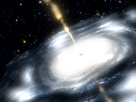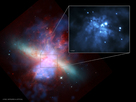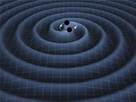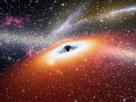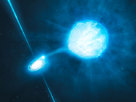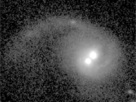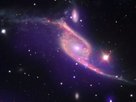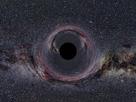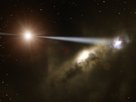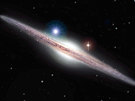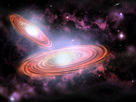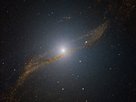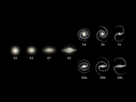A microquasar
Black Hole Blows Big Bubble
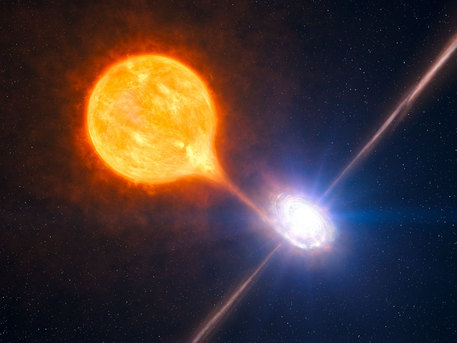 © ESO/L. Calçada
|
The black hole blows a huge bubble of hot gas, 1000 light-years across or twice as large and tens of times more powerful than the other such microquasars. The stellar black hole belongs to a binary system as pictured in this artist’s impression.
Black holes are known to release a prodigious amount of energy when they swallow matter. It was thought that most of the energy came out in the form of radiation, predominantly X-rays. However, the new findings show that some black holes can release at least as much energy, and perhaps much more, in the form of collimated jets of fast moving particles. The fast jets slam into the surrounding interstellar gas, heating it and triggering an expansion. The inflating bubble contains a mixture of hot gas and ultra-fast particles at different temperatures. Observations in several energy bands (optical, radio, X-rays) help astronomers calculate the total rate at which the black hole is heating its surroundings.
The astronomers could observe the spots where the jets smash into the interstellar gas located around the black hole, and reveal that the bubble of hot gas is inflating at a speed of almost one million kilometres per hour.
“The length of the jets in NGC 7793 is amazing, compared to the size of the black hole from which they are launched,” says co-author Robert Soria [1]. “If the black hole were shrunk to the size of a soccer ball, each jet would extend from the Earth to beyond the orbit of Pluto.”
This research will help astronomers understand the similarity between small black holes formed from exploded stars and the supermassive black holes at the centres of galaxies. Very powerful jets have been seen from supermassive black holes, but are thought to be less frequent in the smaller microquasar variety. The new discovery suggests that many of them may simply have gone unnoticed so far.
The gas-blowing black hole is located 12 million light-years away, in the outskirts of the spiral galaxy NGC 7793. From the size and expansion velocity of the bubble the astronomers have found that the jet activity must have been ongoing for at least 200 000 years.
Notes
[1] Astronomers do not have yet any means of measuring the size of the black hole itself. The smallest stellar black hole discovered so far has a radius of about 15 km. An average stellar black hole of about 10 solar masses has a radius of about 30 km, while a “big” stellar black hole may have a radius of up to 300 km. This is still much smaller than the jets, which extend out to several hundreds light years on each side of the black hole, or about several thousand million million km!
Source: ESO - European Southern Observatory
A microquasar
Black Hole Blows Big Bubble
 © ESO/L. Calçada
|
The black hole blows a huge bubble of hot gas, 1000 light-years across or twice as large and tens of times more powerful than the other such microquasars. The stellar black hole belongs to a binary system as pictured in this artist’s impression.
Black holes are known to release a prodigious amount of energy when they swallow matter. It was thought that most of the energy came out in the form of radiation, predominantly X-rays. However, the new findings show that some black holes can release at least as much energy, and perhaps much more, in the form of collimated jets of fast moving particles. The fast jets slam into the surrounding interstellar gas, heating it and triggering an expansion. The inflating bubble contains a mixture of hot gas and ultra-fast particles at different temperatures. Observations in several energy bands (optical, radio, X-rays) help astronomers calculate the total rate at which the black hole is heating its surroundings.
The astronomers could observe the spots where the jets smash into the interstellar gas located around the black hole, and reveal that the bubble of hot gas is inflating at a speed of almost one million kilometres per hour.
“The length of the jets in NGC 7793 is amazing, compared to the size of the black hole from which they are launched,” says co-author Robert Soria [1]. “If the black hole were shrunk to the size of a soccer ball, each jet would extend from the Earth to beyond the orbit of Pluto.”
This research will help astronomers understand the similarity between small black holes formed from exploded stars and the supermassive black holes at the centres of galaxies. Very powerful jets have been seen from supermassive black holes, but are thought to be less frequent in the smaller microquasar variety. The new discovery suggests that many of them may simply have gone unnoticed so far.
The gas-blowing black hole is located 12 million light-years away, in the outskirts of the spiral galaxy NGC 7793. From the size and expansion velocity of the bubble the astronomers have found that the jet activity must have been ongoing for at least 200 000 years.
Notes
[1] Astronomers do not have yet any means of measuring the size of the black hole itself. The smallest stellar black hole discovered so far has a radius of about 15 km. An average stellar black hole of about 10 solar masses has a radius of about 30 km, while a “big” stellar black hole may have a radius of up to 300 km. This is still much smaller than the jets, which extend out to several hundreds light years on each side of the black hole, or about several thousand million million km!
Source: ESO - European Southern Observatory






